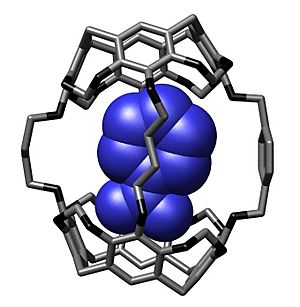Donald J. Cram facts for kids
Quick facts for kids
Donald James Cram
|
|
|---|---|
| Born | April 22, 1919 |
| Died | June 17, 2001 (aged 82) |
| Nationality | American |
| Alma mater | Rollins College (BS) University of Nebraska (MS) Harvard University (PhD) |
| Known for | Cram's rule Host–guest chemistry phenonium ions paracyclophanes |
| Awards | Nobel Prize in Chemistry (1987) Glenn T. Seaborg Medal (1989) National Medal of Science (1993) Guggenheim fellowship (1955) |
| Scientific career | |
| Fields | Chemistry |
| Institutions | UCLA, Merck & Co, MIT |
| Theses |
|
| Doctoral advisor | Louis Fieser |
| Doctoral students | M. Frederick Hawthorne Norman L. Allinger |
Donald James Cram (born April 22, 1919 – died June 17, 2001) was an American chemist. He won the 1987 Nobel Prize in Chemistry along with Jean-Marie Lehn and Charles J. Pedersen. They were honored for their work on creating special molecules. These molecules can recognize and connect with other specific molecules. Their discoveries helped start a new area of science called host–guest chemistry.
Contents
Early life and education
Donald Cram was born in Chester, Vermont. His father was from Scotland and his mother was from Germany. Sadly, his father passed away before Donald turned four. This left him as the only boy in a family of five.
Growing up, his family received financial help. Donald started working at a very young age. He did many different jobs, like picking fruit and delivering newspapers. He even traded work for piano lessons. By the time he was 18, he had worked at least 18 different jobs.
He went to Winwood High School in Long Island, New York. From 1938 to 1941, he attended Rollins College in Winter Park, Florida. He earned a scholarship and worked in the chemistry department. He was also involved in theater and music. At Rollins, he became known for building his own chemistry equipment. In 1941, he earned his bachelor's degree in chemistry.
In 1942, he received his master's degree in organic chemistry from the University of Nebraska–Lincoln. His research was about how certain chemicals react. Later, in 1947, he earned his PhD in organic chemistry from Harvard University. His advisor there was Louis Fieser.
A career in chemistry
From 1942 to 1945, Cram worked at Merck & Co laboratories. He helped with research on penicillin, an important medicine. After that, he did more research at the MIT.
Cram created something called Cram's rule. This rule helps scientists predict how certain chemical reactions will turn out. He wrote over 350 research papers and eight books about organic chemistry. He also taught many students from all over the world.
Discovering new molecules
Donald Cram built on the work of Charles J. Pedersen. Pedersen had created "crown ethers," which are flat, ring-shaped molecules. These molecules can grab onto specific metal atoms. Cram took this idea and made molecules that were three-dimensional. Imagine a tiny cage or container made of molecules.
These new 3D molecules could selectively interact with other chemicals. This was because their shapes fit together perfectly, like puzzle pieces. Cram's work was a big step towards making artificial versions of natural molecules. For example, enzymes in our bodies have special shapes that help them do their jobs. Cram's research helped create lab-made molecules that could act in similar ways. He also studied stereochemistry, which is about the 3D arrangement of atoms in molecules.
In 1973, Cram worked with an Irish chemist named Francis Leslie Scott on research.
A beloved professor
In 1947, Cram became an assistant professor at the University of California, Los Angeles (UCLA). He became a full professor in 1955 and taught there until he retired in 1987. He was a very popular teacher. He taught about 8,000 undergraduate students during his career. He also guided 200 graduate students in their studies. He would sometimes play his guitar and sing folk songs to entertain his classes.
Awards and recognition
Donald Cram received many important awards for his work.
- Nobel Prize in Chemistry (1987)
- Glenn T. Seaborg Medal (1989)
- National Medal of Science (1993)
- NAS Award in Chemical Sciences
- Willard Gibbs Award (1985)
- Arthur C. Cope Award (1974)
- Member of the National Academy of Sciences (1961)
His personal journey
Donald Cram once shared that his dedication to science required sacrifices. His first wife was Jean Turner, whom he met at Rollins College. His second wife, Jane, was also a chemistry professor. Cram focused completely on his scientific work. He believed that he could either be a great scientist or a great parent, and he chose to dedicate himself to science.
Donald Cram passed away from cancer in 2001. He was 82 years old.
See also
 In Spanish: Donald James Cram para niños
In Spanish: Donald James Cram para niños


